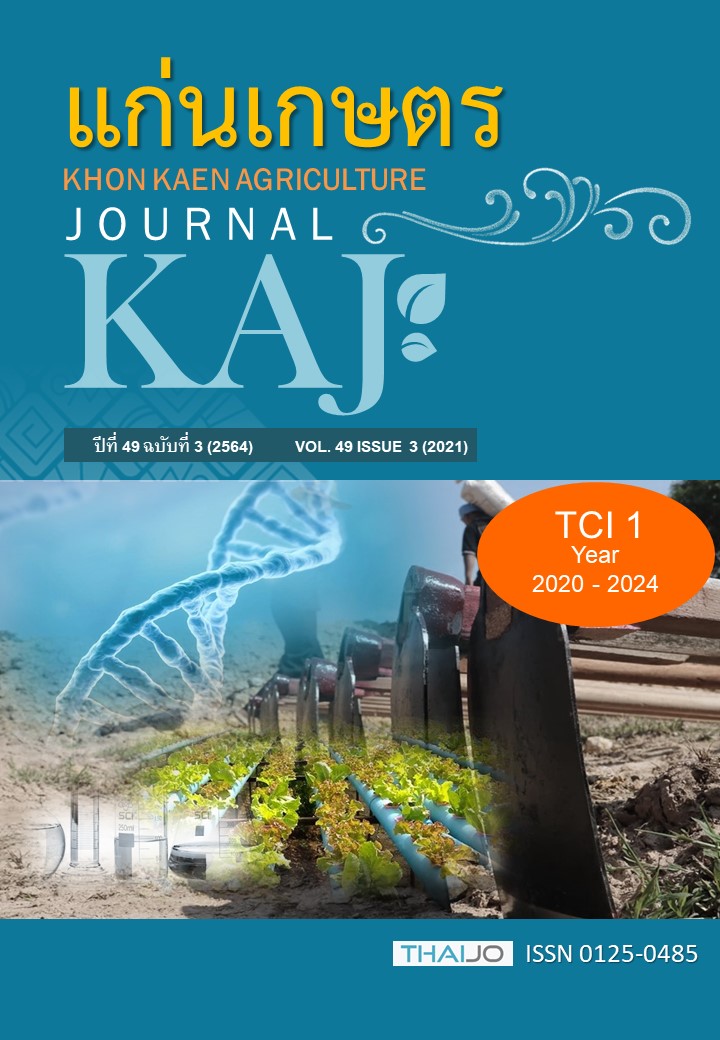ฤทธิ์ต้านเชื้อราของสารสกัดพรอพอลิสจากชันโรง Tetragonula pagdeni (Schwarz) ในการยับยั้งเชื้อราสาเหตุโรคเน่าราเขียวในส้มเขียวหวาน
Main Article Content
บทคัดย่อ
โรคเน่าราเขียวที่เกิดจากเชื้อรา Penicillium spp. ก่อปัญหาให้กับส้มเขียวหวานหลังการเก็บเกี่ยวเป็นอย่างมาก การใช้สารเคลือบผิวส้มที่มาจากธรรมชาติมีส่วนประกอบของสารที่ป้องกันการระเหยของน้ำ และมีฤทธิ์ยับยั้งเชื้อรา จึงจำเป็นเพื่อลดสารตกค้างอันตรายต่อผู้บริโภค งานวิจัยนี้มีวัตถุประสงค์เพื่อศึกษาประสิทธิภาพของตัวทำละลายและความเข้มข้นที่เหมาะสมของสารสกัดพรอพอลิสที่ได้จากชันโรงในประเทศไทย ในการยับยั้งการเจริญของเชื้อราสาเหตุโรคเน่าราเขียวในส้มเขียวหวาน โดยพรอพอลิสถูกสกัดด้วยตัวทำละลาย 3 ชนิด คือ อะซิโตน เอทานอล และเมทานอล และนำไปทดสอบประสิทธิภาพแบบ in vitro ในการยับยั้งการเจริญของเส้นใยเชื้อราก่อโรคเน่าราเขียวที่แยกได้จากผลส้ม ที่ความเข้มข้นร้อยละ 1, 2.5 และ 5 โดยน้ำหนักต่อปริมาตร ผลการทดสอบพบว่าสารสกัดพรอพอลิสเมทานอล (PME) ที่ความเข้มข้นร้อยละ 2.5 ซึ่งสามารถยับยั้งการเจริญของเส้นใยเชื้อราได้มากที่สุด (ร้อยละ 65.80±8.35) ไม่แตกต่างทางสถิติกับสารสกัดจากพรอพอลิสชนิดอื่น ยกเว้น สารสกัดพรอพอลิสเอทานอล (PEE) ที่ความเข้มข้นร้อยละ 2.5 โดยน้ำหนักต่อปริมาตร โดยที่ค่าเฉลี่ยรวมร้อยละการยับยั้งการเจริญของเชื้อราสูงสุดเป็นของสารสกัดพรอพอลิสอะซิโตน (PAE) รองลงมาคือ สารสกัดพรอพอลิสจากเมทานอล (PME) และเอทานอล (PEE) ตามลำดับ
Article Details

อนุญาตภายใต้เงื่อนไข Creative Commons Attribution-NonCommercial-NoDerivatives 4.0 International License.
เอกสารอ้างอิง
เบญจมาภรณ์ ศรีคำแหง. 2548. การควบคุมโรคเน่าราเขียวของผลส้มพันธุ์สายน้ำผึ้งหลังการเก็บเกี่ยวโดยใช้กรดอินทรีย์ร่วมกับสารเคลือบผิว. วิทยานิพนธ์ปริญญาวิทยาศาสตรมหาบัณฑิต มหาวิทยาลัยเชียงใหม่, เชียงใหม่.
วชิราภรณ์ ฟูนัน. 2562. วิธีการสกัดสารสกัดหยาบจากพรอพอลิสของชันโรงที่มีผลต่อการยับยั้งการเจริญของเชื้อราก่อโรคผลไม้หลังการเก็บเกี่ยว. (ออนไลน์). ใน: ประชุมวิชาการระดับชาติ “วลัยลักษณ์วิจัย” ครั้งที่ 11 วันที่ 27-28 มีนาคม 2562. มหาวิทยาลัยวลัยลักษณ์, นครศรีธรรมราช.
วิจิตรา ลีละศุภกุล. 2547. การควบคุมโรคผลส้มหลังการเก็บเกี่ยวโดยชีววิธี. รายงานวิจัยฉบับสมบูรณ์ ทุนงบประมาณแผ่นดิน. มหาวิทยาลัยสงขลานครินทร์.
ศิริวรรณ อธิคมกุลชัย. 2550. พรอพอลิส: ของขวัญจากธรรมชาติ. วารสารไทยเภสัชศาสตร์และวิทยาการสุขภาพ. 3: 286-295.
สำนักงานเศรษฐกิจการเกษตร กระทรวงเกษตรและสหกรณ์. 2562. ส้มเขียวหวาน: เนื้อที่ยืนต้น เนื้อที่ให้ผล ผลผลิต และผลผลิตต่อไร่ ปี 2562. http://www.oae.go.th/assets/portals/1/fileups/prcaidata/files/lime62.pdf. ค้นเมื่อ 20 กุมภาพันธ์ 2563.
สำนักวิจัยและพัฒนาวิทยาการหลังการเก็บเกี่ยวและแปรรูปผลิตผลเกษตร กรมวิชาการเกษตร. 2557. โรคผลไม้หลังการเก็บเกี่ยว. จามจุรีโปรดักส์, กรุงเทพฯ.
สุพรรณิการ์ สมใจเพ็ง และรังสิยา แก้ววิเชียร. 2563. การยับยั้งการเจริญของเชื้อรา Penicillium sp. และ Fusarium sp. ที่คัดแยกได้จากพริกไทย (Piper nigrum L.) โดยใช้สารประกอบกลุ่ม GRAS. แก่นเกษตร. 48 (ฉบับพิเศษ 1): 1189-1196.
อัญชลี สวาสดิ์ธรรม. 2556. มหัศจรรย์ชันโรง. ทริปเพิ้ล กรุ๊ป, กรุงเทพฯ.
Dirar, A. I., D. H. M. Alsaadi, M. Wada, M. A. Mohamed, T. Watanabe, and H. P. Devkota. 2019. Effects of extraction solvents on total phenolic and flavonoid contents and biological activities of extracts from Sudanese medicinal plants. South African Journal of Botany. 120: 261-267.
Do, Q. D., A. E. Angkawijaya, P. L. Tran-Nguyen, L. H. Huynh, F. E. Soetaredjo, S. Ismadji, and Y. Ju. 2014. Effect of extraction solvent on total phenol content, total flavonoid content, and antioxidant activity of Limnophila aromatica. Journal of Food and Drug Analysis. 22: 296-302.
El- Fadaly, H., and E. E. Y. El-Badrawy. 2001. Flavonoids of propolis and their antibacterial activities. Pakistan Journal of Biological Sciences. 4: 204-207.
Hernández Zarate, M. S., M. R. Abraham Juárez, A. Cerón García, C. Ozuna López, A. J. Gutiérrez Chávez, J. J. N. Segoviano Garfias, and F. Avila Ramos. 2018. Flavonoids, phenolic content, and antioxidant activity of propolis from various areas of Guanajuato, Mexico. Food Science and Technology. 38: 210-215.
Koc, A. N., S. Silici, F. Mutlu-Sariguzel, and O. Sagdic. 2007. Antifungal activity of propolis in four different fruit juices. Food Technology and Biotechnology. 45: 57–61.
Matny, O. N. 2015. Efficacy evaluation of Iraqi propolis against gray mold of stored orange caused by Penicillium digitatum. Plant Pathology Journal. 14(3): 153-157.
Matny, O. N., S. H. S. Al-Warshan, and A. M. Ali. 2015. Antifungal evaluation of Iraqi propolis against Penicillium expansum and mycotoxin production in apple. International Journal of Current Microbiology and Applied Sciences. 4: 399-405.
Moraes Bazioli, J., J. R. Belinato, J. H. Costa, D. Y. Akiyama, J. G. de Moraes Pontes, K. C. Kupper, F. Augusto, J. E. de Carvalho, and T. P. Fill. 2019. Biological control of citrus postharvest phytopathogens. Toxins (Basel). 11(8): 460.
Peng, L., S. Yang, Y. J. Cheng, F. Chen, S. Pan, and G. Fan. 2012. Antifungal activity and action mode of pinocembrin from propolis against Penicillium italicum. Food Science and Biotechnology. 21: 1533–1539.
Sánchez, C., P. Duarte., P. Vasilenko., M. Santos., M. Loebler., A.S. Cruz., and M. Gonçalves. 2016. Potential application of Portuguese propolis to control blue mould disease in 'Rocha' pear. Acta Horticulturae. 1144: 359-364.
Soylu, E. M., A. E. Özdemir, E. Ertürk, N. Sahnler, and S. Soylu. 2008. Antifungal activity of propolis against postharvest disease agent Penicillium digitatum. Asian Journal of Chemistry. 20: 4823-4830.
Temiz, A., A. S. Mumcu, A. Ö. Tüylü, K. Sorkun, and B. Salih. 2013. Antifungal activity of propolis samples collected from different geographical regions of Turkey against two food-related mold, Aspergillus versicolor and Penicillium aurantiogriseum. GIDA-The Journal of Food. 38: 135-142.
Xu, X., R. Pu, Y. Li, Z. Wu, C. Li, X. Miao, and W. Yang. 2019. Chemical compositions of propolis from China and the United States and their antimicrobial activities against Penicillium notatum. Molecules. 24: 3576.
Yang, S., L. Peng, Y. Cheng, C. Feng, and P. Siyi. 2010. Control of citrus green and blue molds by Chinese propolis. Food Science and Biotechnology. 19: 1303–1308.


